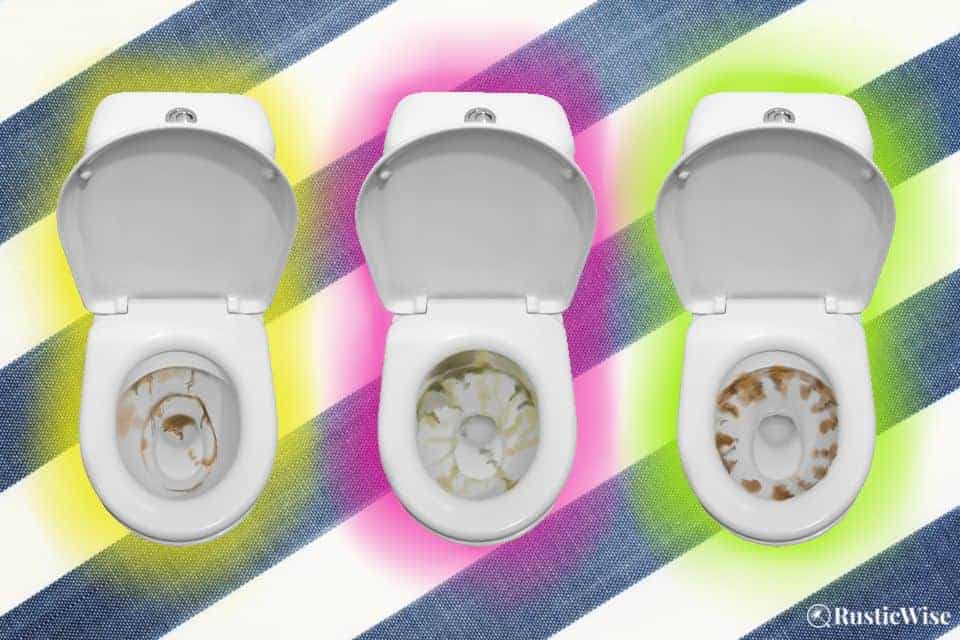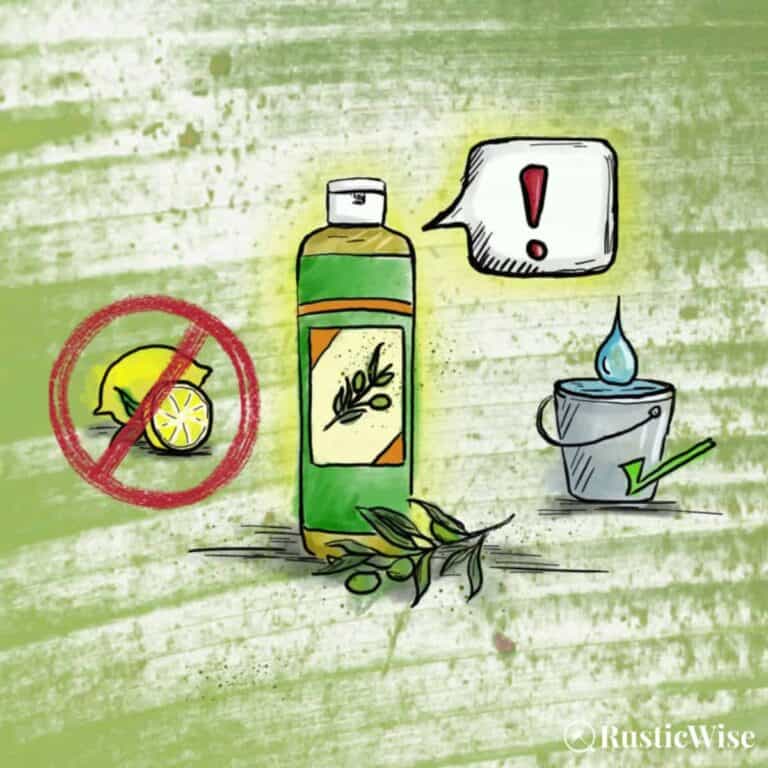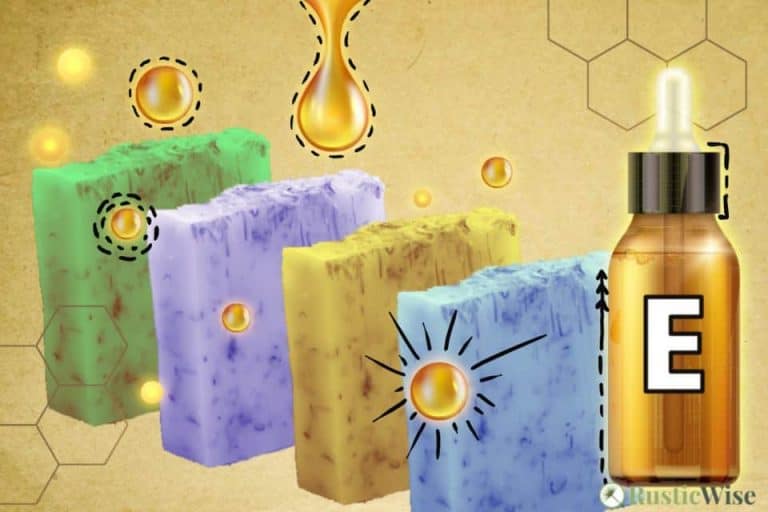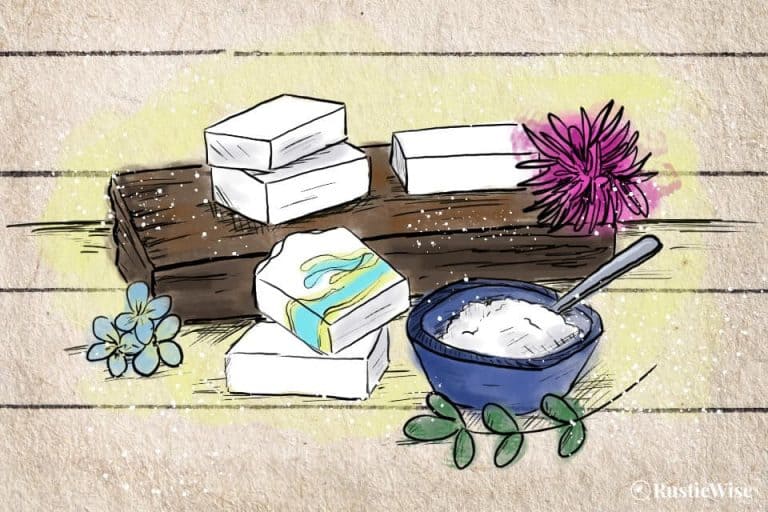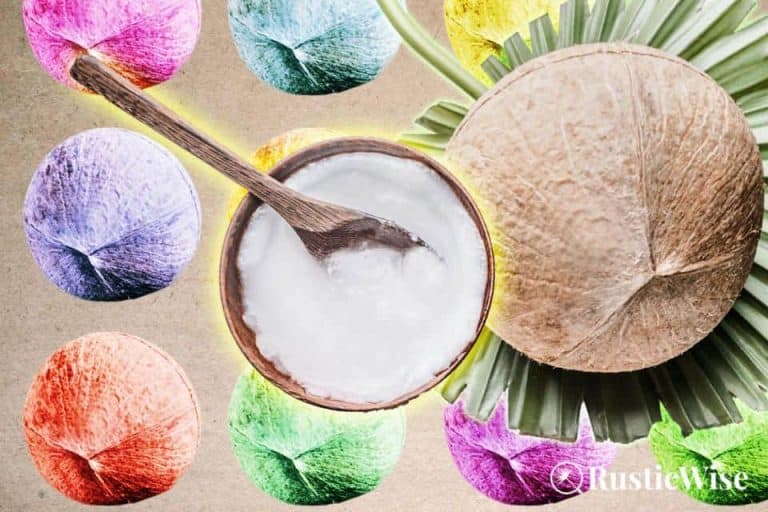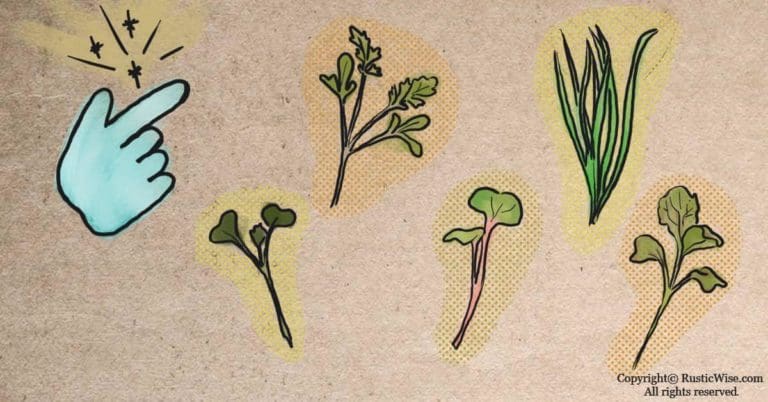6 Types of Toilet Bowl Stains and How to Remove Each One
RusticWise is supported by its readers. When you purchase through links on our site, we may earn an affiliate commission. As an Amazon Associate, we earn from qualifying purchases. Thank You!
Sometimes a toilet gets dirty from pure neglect (we’ve all been there). Other times, toilet bowl stains develop quickly for no apparent reason.
Here’s a roundup of 6 of the most common toilet bowl stains along with a guide on how to best remove stubborn stains to get your bowl sparkling clean. From removing hard water stains to tackling black stains or a rust stain, I’ll show you how to clean toilet stains and prevent them from coming back.
I’ll also cover a few common cleaning ingredients and supplies you’ll need to get started. Many of these ingredients are affordable and ones that you likely already have at home.
Roll up your sleeves and get ready to use a bit of elbow grease!
A few house cleaning safety tips before you get started
Virtually all commodes are made of porcelain, also known as Vitreous China, a type of special clay. Materials used for toilet seats vary. Generally, a toilet seat is made of vinyl plastic, resin, or some type of manufactured wood. Make sure whatever product you use is safe for these materials!¹
- Avoid using metal scrubbies, steel wool pads, or metal tools in the toilet which can scratch and damage the porcelain. You may get dull, grey marks (which is something nobody wants).
- Beware of pumice stones! While many claim these are safe to use on toilets, if used too vigorously, a pumice stone can damage the porcelain finish. Check your manufacturer’s instructions as some may caution against using pumice stones.
- Never mix bleach with other cleaners. Mixing bleach with ammonia or vinegar can create toxic gas!
- Don’t mix different cleaners together. For example, if you have a leave-in cleaner in your toilet tank, remove it before applying toilet bowl cleaner.¹
- Only apply toilet bowl cleaner to the inside of the bowl as intended. Don’t apply to the outside.
Tip: If you have hard water, it’s especially important to clean regularly. Remember to clean the rim holes (where mineral deposits can form). Use a long-handled brush to reach deep into the trap where mineral deposits also like to develop.
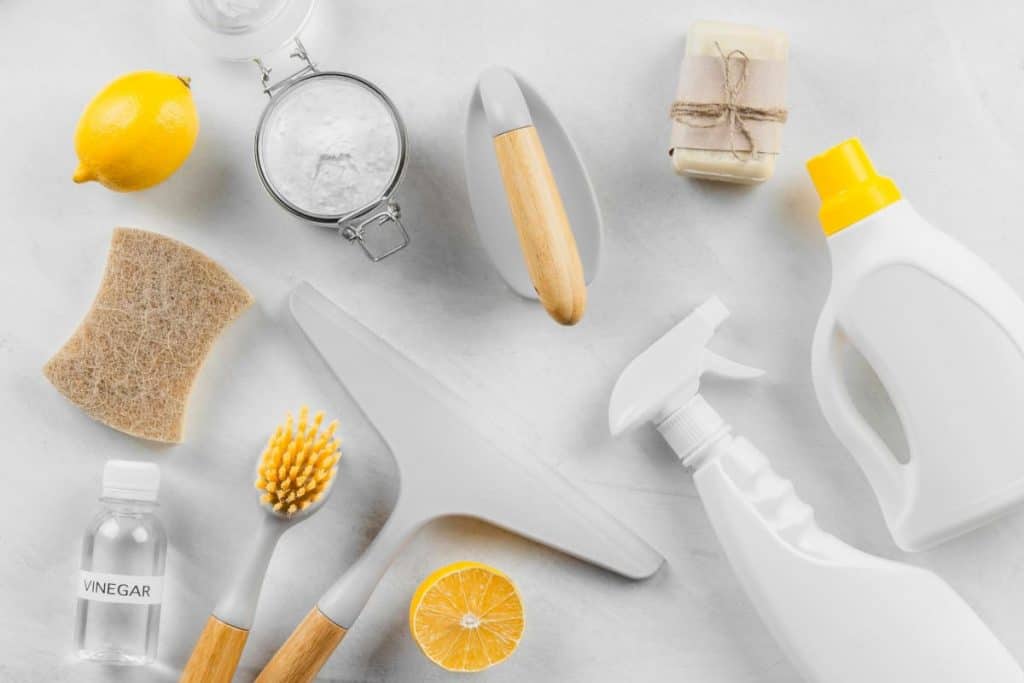
Basic toilet cleaning ingredients
While there are many chemical-based toilet cleaners, you can still get the job done with a few natural cleaning supplies.
You’ve probably heard of DIY toilet cleaners using vinegar and baking soda.
When combining an acid (vinegar) with a base (baking soda), a chemical reaction occurs—fizzing and bubbling! You want the chemical reaction to happen in the toilet bowl which is why it’s important you don’t pre-mix the ingredients before adding. Add the baking soda first, then the vinegar second.
Check out our section at the bottom of this article on DIY toilet cleaner recipes using these basic ingredients. We’ve organized them from mild, moderate, to downright stubborn!
- Distilled white vinegar: White vinegar is a cleaning workhorse . Not only is it affordable, it’s also effective as a mild disinfectant. As an acidic ingredient, vinegar works to dissolve hard mineral deposits and remove rust stains. The secret to this cleaning solution is its acetic acid. Most bottles of white vinegar contain around 5 percent acetic acid. Some pickling vinegars contain higher levels, around 7 percent.
- Baking soda: Sodium bicarbonate acts as a mild abrasive and a mild alkaline ingredient, great for scrubbing!
- Borax: A stronger alkali than baking soda, borax (sodium tetraborate) comes from a naturally occurring mineral mined from the earth. Take care not to get borax into your eyes, or inhale.
- Toilet cleaners: While there are countless toilet cleaners on the market, there are also some eco-friendly (or less harsh) varieties that still clean—minus the harsh chemicals. Many of these use a combination of citric acid, essential oils, and are biodegradable to boot. Check out Method Toilet Cleaner, or Seventh Generation Toilet Bowl Cleaner.
Toilet cleaning supplies
Gather a few cleaning tools to tackle tough stains in your porcelain bowl.
- Rubber gloves to protect your hands
- Long-handled toilet brush
- Empty spray bottle
- Plastic scrubbie (or sponge) for scrubbing stains
- Old rags
6 Common types and causes of toilet stains (and how to remove them)
Not only are lavatory stains unsightly, the moist conditions of a loo make it an ideal place for bacteria, mold, and mildew to develop.
The longer you let stains sit, the harder it is to remove! Let’s take a closer look at the various stains and rings in toilets, and what causes them.
1. Crusty, white or grey, toilet bowl buildup (mineral deposits)
That white crusty stuff that develops around the toilet bowl is most likely a buildup of hard water minerals. Common minerals that cause buildup are calcium and magnesium. Sometimes this is called limescale.²
If you have hard water, you may notice a white or light-grey ring develop around the waterline. (You’ll sometimes see this phenomenon appear around the edges of a swimming pool.)
In toilets, this develops a white (or grey) ring where the water sits. If you have a toilet that’s infrequently used (such as a guest toilet), this crusty stuff has a higher chance of developing.
How to clean mineral buildup in toilet bowls
Stubborn hard water toilet stains could benefit from vinegar and baking soda (see the section below on how to remove mild to moderate toilet stains.
You can also clean hard water stains with a good toilet bowl cleaner. Some toilet bowl cleaners are specifically made to fight hard water deposits.
- Apply toilet bowl cleaner to the rim of the bowl.
- Let it sit for several minutes.
- Use a toilet brush or a small toothbrush to gently scrub away the buildup.
- Swish the water around the bowl and flush.
Tip: It’s a good practice to flush your toilet periodically to get the water moving if it’s infrequently used.
2. Black, orange, or green rings in toilet
The appearance of black, orange, or green rings in a toilet bowl is most often the result of mold or mildew growth.²
Mildew and mold love humid environments so it’s no surprise they love toilet bowls! They are also more prone to develop in poorly ventilated bathrooms. So open the window (if you have one), turn on the fan when having showers, and keep the bathroom door open to allow fresh air to circulate.
How to remove mold or mildew stains in toilet
To protect yourself from breathing in mold spores, wear a mask, and wear gloves.
First, you’ll start by cleaning, followed by a disinfectant spray.
Start by using a commode cleaner. Apply around the rim of the bowl and let it sit for several minutes. Scrub with a toilet brush and flush.
Follow up with disinfectant spray with a bit of liquid chlorine bleach. While I normally don’t like to use bleach for cleaning unless absolutely necessary, I think mold is a good reason to pull out the big guns, don’t you?
Never mix bleach with ammonia and other cleaners as it can release toxic fumes.
It’s important to dilute bleach first.
The CDC recommends using 4 teaspoons of bleach per quart (roughly 4 cups) of room temperature water for household disinfection.³
- Combine bleach solution in a clean spray bottle.
- Spray cleaning solution into the toilet bowl, making sure to focus on all the nooks and crannies such as under the rim, under the toilet seat, along the water jets, etc.
- Let the bleach solution sit for at least 5 minutes. This sitting time is important for proper disinfection, so don’t skip this step!
- Clean with toilet brush.
- Flush.
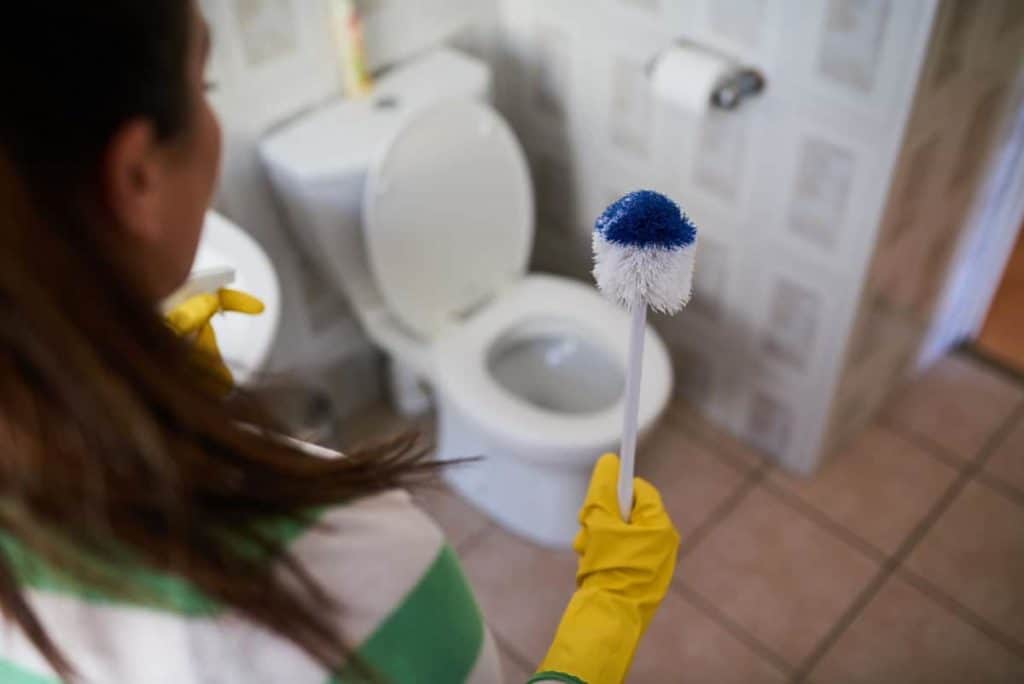
3. Pink toilet stains
Seeing pink toilet rings?
Most often, pink stains come from an airborne bacteria that develops a pink (sometimes pink-gray) residue on moist surfaces such as toilet bowls and showers. The most common type of bacteria to cause pink residue is Serratia Marcescens, a naturally occurring bacteria found in animals, food, and soil.²
You’ll find this pink stuff in areas where there’s sitting water. In toilets, these bacteria often form pink rings around the waterline.
Sometimes, pink stains in the toilet may come from iron residues from old house pipes. (If this is the case, pink stains would occur in all areas of the house where there’s water.)²
How to remove pink toilet stains
The best way to prevent pink stains is to wipe down any moist surfaces and to give your toilet a scrub with toilet cleaner on the regular.
Since the Serratia Marcescens bacteria naturally occurs in the environment, it’s best to make regular toilet scrubbing part of your weekly cleaning routine to banish stains as they occur.
And remember to flush toilets regularly that are infrequently used to let fresh water circulate.
4. Yellow toilet bowl stains
Nobody wants a yellow toilet. While it’s easy to assume that yellow stains result from urine, it likely has to do with tannins in water. The yellow stain color can range from pale yellow to a darker yellow-brown (almost like tea.)²
Tannins in water come from broken down organic matter. Unfortunately, tannins are very difficult to filter out of water systems.
How to remove yellow stains from toilet
The best way to remedy golden stains in the toilet is to keep them at bay with regular cleaning! Try the solution below featuring borax and hot water in the section on moderate stains.
If stubborn stains remain, check out the section below on removing stubborn stains.
5. Red or rust stains in toilet bowl
The appearance of reddish or rust-colored stains in a toilet is often a sign of iron in the water.
To prevent rust stains, you’ll need to get at the root of the problem by installing an iron removal system at the main water supply.
Having rust-colored stains may also be a sign of a bigger problem with your pipes and corrosion. You may need to call an expert to look at your home if the issue persists.
How to remove red rust stains from toilet
Acidic-based cleaners such as vinegar work best to remove signs of rust and other mineral buildup. If a mild vinegar solution doesn’t do the trick, there are also commercial cleaners that remove rust.
You could try using a bit of CLR (calcium, lime, and rust) on problem areas. Remember to put on a pair of protective gloves!
CLR provides the following instructions: ⁴
- Turn off the water supply to the toilet.
- Flush the water from the bowl.
- Pour 1 cup of CLR into the bowl.
- Let it sit for 2 minutes.
- Scrub the bowl with a toilet brush to loosen the soil.
- Turn the water supply back on.
- Flush.
6. Brown, green or blue toilet stains
What causes stubborn brown stains in the toilet? Often brown stains result from too much manganese in the water. ²
Sometimes brown stains are also caused by mineral buildup (limescale) that accumulates over time. Dirt particles and bacteria develop layers over time, which causes the brownish coloring. While limescale often starts out white, it can begin to pick up other colors too. (This can occur in toilets that aren’t regularly scrubbed!).
Similar to having too much iron (red/rust stains), you can also install an iron and manganese removal system at the main water supply.
Blue or green stains are more troublesome. Sometimes they are a sign of mold or mildew growth.
Other times, it may be a sign of a more complicated issue with the water supply. Here are a few potential causes of blue or green toilet stains:
- Water that’s too acidic or alkaline: Water that’s not within a normal neutral pH range may cause copper or brass pipes to leak a blue or green color into the water.²
- Electrolysis: Sometimes this occurs when two incompatible metals or materials come into contact with one another. For example, having a variety of pipes (PVC, copper, etc.). Or, metal piping may be incorrectly ground. This occurs sometimes in remodelled homes.²
- Chloramine: Some city districts use chloramine (a combination of chlorine and ammonia) to disinfect water. Sometimes blue or green stains occur in areas using this chemical.²
How to remove brown or blue green stains from toilet bowl
These types of stains are some of the most stubborn and difficult to remove. Check out the section below on how to remove stubborn toilet stains.
You’ll need to use a combination of a strong acidic solution, combined with abrasives and some good old-fashioned elbow grease.
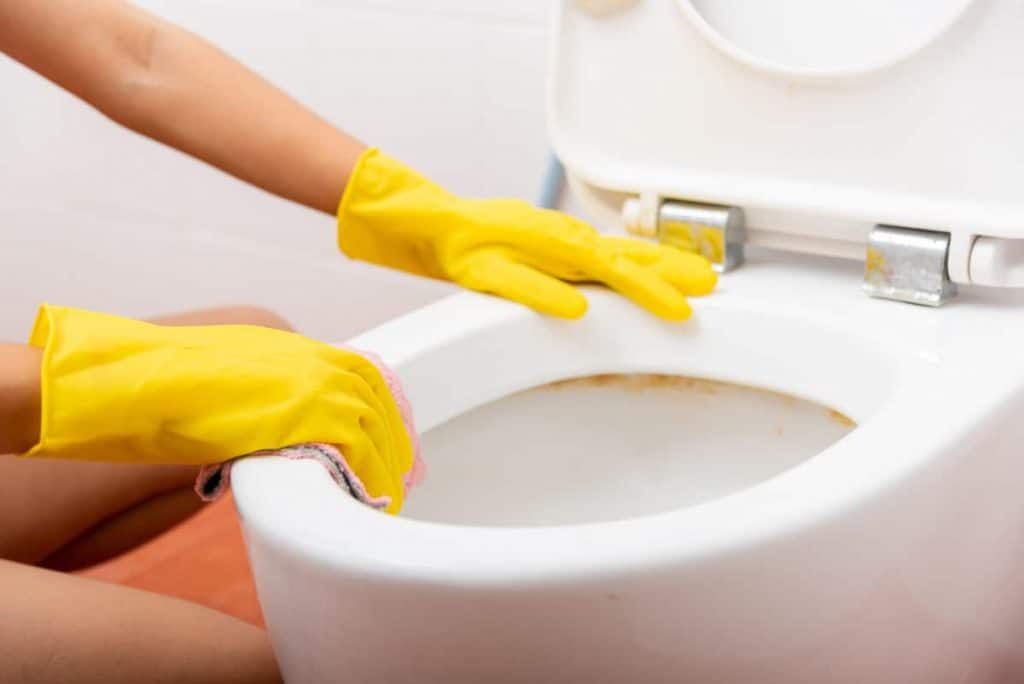
How to remove stubborn toilet stains with vinegar and borax
Sometimes, no amount of scrubbing can remove stubborn and unsightly toilet stains. The most difficult to remove toilet stains are often brown, blue, or green. Here’s how to clean toilet bowl stains.
We had a persistent brown toilet stain along the bottom of the toilet bowl (probably from hard mineral buildup). It was the main floor toilet that guests would use, so we knew we had to get rid of it fast!
Here’s what we did.
You’ll need:
- 1/2 cup pickling vinegar (see note below)
- 1 cup borax
- Plastic scrubby
- Sponge
- Rubber gloves
- Plunger
- Old rags
- Optional: A spray bottle is handy if you want to get the vinegar into nooks and crannies.
Note: We used a bottle of Allen’s Pickling Vinegar, which contains 7 percent acetic acid. Most regular white vinegar bottles contain around 5 percent acetic acid. While you can definitely use regular white vinegar, the higher acetic acid content bumps up the cleaning power.
- Turn off the water supply to the toilet.
- Flush. You want to have little to no water sitting in the bowl for maximum effectiveness.
- Plunge out any remaining water.
- Sprinkle borax onto the stains for extra scrubbing action. Borax is a strong alkali abrasive, so put on your gloves and avoid breathing in, or getting into eyes.
- Pour roughly ½ cup of vinegar undiluted directly into the bowl (or using a spray bottle).
- Use the sponge to soak up some vinegar and let the vinegar-soaked sponge sit on stubborn deposit stains where needed.
- Let vinegar sit for several hours, or overnight. This allows the acetic acid in the vinegar to dissolve and loosen mineral deposits.
- Use a plastic scrubber to gently scrub the stains off. Never use metal tools as it can damage the finish of the porcelain and leave grey marks!
- Turn the water supply on and flush the toilet.
- All or most of the hard mineral stains should be gone. If not, follow up with a regular clean with toilet bowl cleaner and a brush.
Note: We’ve used this method with just the pickling vinegar (no borax) and it still worked fine!
How to remove mild-to-moderate toilet stains
For regular cleaning, or for mild cleaning of your throne room, use the power of baking soda and vinegar.⁵
Mild toilet cleaner
- ¼ cup baking soda
- 1 cup vinegar
Sprinkle the baking soda around the toilet bowl. Add the vinegar next. The solution will begin fizzing. Let it sit for 15–30 minutes. Scrub with brush and flush.
Moderate toilet cleaner
- ½ cup borax
- 1 gallon of hot (not boiling water)
Note: Borax is a stronger alkali than baking soda and is helpful when you need to remove moderate stains. Avoid pouring boiling water as it may crack the toilet bowl.
Sprinkle borax into toilet bowl, making sure to cover any toilet stains. Let it sit for at least 30 minutes, or longer if needed. Pour the hot (not boiling water) into the bowl. Scrub with brush and flush.
How to keep your toilet sparkling clean
You won’t like this answer. But the best way to keep your throne sparkling clean (or at least avoid toilet bowl stains), is to give the bowl a quick scrub at least once a week.
This is really important if you have hard water. Scrub the water jets around the toilet rim. And use a long-handled toilet brush to reach deep into the trap, which is where most hard minerals accumulate.
If you have really hard water that is constantly making your cleaning job tougher, you might consider investing in a water softener.
Related questions
Does Coca Cola clean toilets?
Yes, you can use Coke to clean toilets. It contains carbonic acid, which helps to remove deposits and some rust stains. Simply pour some cola into the toilet bowl and let it sit awhile. Follow up with a scrub and then flush.
I’ve tried this method at home. It works okay, but doesn’t work as well as straight-up pickling vinegar in my experience.
Does vinegar remove rust from toilet?
Yes, as an acid, vinegar works to remove rust and hard mineral stains. For stronger cleaning power, try pickling vinegar, which contains more acetic acid. You can also try a bottle of CLR.
How do I get rid of brown limescale in my toilet?
Limescale in toilets develops if you have hard water mineral deposits. Acidic ingredients such as vinegar, citric acid, and commercial toilet cleaners work to break down the hard water deposits. Check out the section above on how to remove stubborn toilet stains with vinegar + borax for cleaning tips on how to get brown stains out of toilet.
What removes hard toilet stains?
Most stubborn toilet stains are brown, green, or blue. A bit of pickling vinegar does the trick. Check out the section above on how to remove stubborn toilet stains with vinegar + borax.
Does vinegar damage toilet bowls?
No, vinegar is safe to use on most porcelain bowls. While it’s acidic, it’s still milder than many other acidic toilet cleaners. You could always check your manufacturer’s instructions for more details.
How many minutes should you leave toilet bowl cleaner in the toilet bowl?
For regular cleaning (without major stains), I would recommend leaving it on for at least 20 minutes. Many people scrub and flush right away, which doesn’t give the cleaner a chance to work its magic. For tougher stains, I would leave on for at least an hour or more.
Will vinegar and baking soda remove hard water stains from toilet?
Yes, the acetic acid in vinegar combined with the mild abrasiveness of baking soda can work to remove hard water stains from a toilet. For a stronger solution, check out our moderate toilet cleaner recipe above. For extra nasty stains, check out the section how to remove stubborn toilet stains with vinegar + borax.
Can toilet bowl cleaner sit overnight?
Yes, you can. Letting it sit overnight might help to work out stubborn stains.
What happens if you leave bleach in a toilet too long?
If you leave bleach in your toilet for too long, the fumes could irritate your eyes and lungs. It’s always best to pour a diluted bleach solution into toilets and not straight-up bleach from the bottle. Bleach is very strong and if left too long in the toilet could damage the porcelain finish.
Can you clean a badly stained toilet bowl?
Yes, but you might have your work cut out for you! First, start with a toilet bowl cleaner and brush to remove general grime and dirt. Next, you might need to break out the vinegar and borax for a strong cleaner to remove mineral deposits. Check out the section above, how to remove stubborn toilet stains with vinegar + borax.
👉 If you like this post, see other Timeless Cleaning Tips You Need To Know. 🌟
Would you like more timeless tips via email?
Fun tips to help you live an independent, self-sustaining lifestyle. Opt-out at any time.


References
- American Cleaning Institute, Cleaning Hard Surfaces, Vitreous China, https://www.cleaninginstitute.org/cleaning-tips/cleaning-hard-surfaces. Accessed October 2023.
- The City of DeSoto, Texas, Homeowners Guide to Stains Rings Discoloration and Mineral Deposits, https://www.ci.desoto.tx.us/DocumentCenter/View/11555/Homeowners-Guide-to-Stains-Rings-Discoloration-and-Mineral-Deposits. Accessed October 2023.
- Centers for Disease Control and Prevention (CDC), Cleaning and Disinfecting With Bleach, https://www.cdc.gov/hygiene/cleaning/disinfecting-bleach.html. Accessed October 2023.
- CLR, How to Clean a Toilet, https://clrbrands.com/How-To/Videos/Clean-a-Toilet. Accessed October 2023.
- University of Arkansas, Clean and Green Homemade Cleaners, https://www.uaex.uada.edu/environment-nature/water/quality/clean-green-homemade-cleaners.aspx. Accessed October 2023.

Author: Josh Tesolin
Josh is co-founder of RusticWise. When he’s not tinkering in the garden, or fixing something around the house, you can find him working on a vast array of random side projects.

